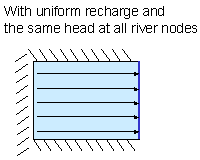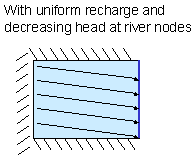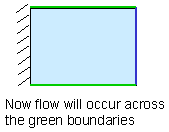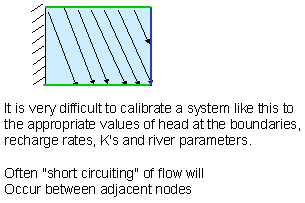Surround the area with 3 no-flow boundaries and a river, stream, general head or constant head boundary to represent the drainage. Schematically, in a simplified rectangular format:

This suggests that flow is generally towards the river

with variations depending on the values of head fixed along the river.

This assumes that the prevailing flow field is trivial compared to the lateral flow to the river and/or the stress to be induced.
Another possibility:
Define a no-flow boundary at the edge of the basin, specified heads at the elevation of the water table at the "arbitrary" boundaries and a river, stream, general head or constant head boundary to represent the drainage. Again, schematically, in a simplified rectangular format:

Depending on the relative values of heads, K's, recharge rates and river parameters, many variations of the flow field can be represented

REGARDLESS of the choice of BOUNDARY CONDITIONS the BOUNDARIES MUST BE FAR ENOUGH FROM THE STRESS that there is MINIMAL IMPACT of the stress on the boundaries.
CHECK this by MONITORING the CHANGE IN HEAD after the stress at the NO-FLOW boundaries and the CHANGE IN FLOW at the FIXED HEAD boundaries.
Another possibility is to use "nested" or "telescoped" models. In this case a large scale model is executed to capture the regional affects and to define the changing value of heads at the hatched boundaries

so that they can be applied to the specified head (green) boundaries.

This approach allows consideration of variation of the other stresses in the basin as well.